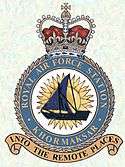RAF Khormaksar
| RAF Khormaksar | |||||||
|---|---|---|---|---|---|---|---|
| Aden in Yemen | |||||||
|
Motto: Into the Remote Places | |||||||
 RAF Khormaksar Shown within Yemen | |||||||
| Coordinates | 12°49′46″N 045°01′45″E / 12.82944°N 45.02917°ECoordinates: 12°49′46″N 045°01′45″E / 12.82944°N 45.02917°E | ||||||
| Type | Royal Air Force station | ||||||
| Site information | |||||||
| Owner | Ministry of Defence | ||||||
| Operator | Royal Air Force | ||||||
| Site history | |||||||
| Built | 1917 | ||||||
| In use | 1917 - 29 November 1967 | ||||||
| Airfield information | |||||||
| Identifiers | IATA: ADE, ICAO: OYAA | ||||||
| Elevation | 1 metre (3 ft 3 in) AMSL | ||||||
| |||||||
Royal Air Force Khormaksar or more simply RAF Khormaksar is a former Royal Air Force station in Aden, Yemen . Its motto was "Into the Remote Places". During the 1960s, it was the base for nine squadrons and became the RAF's busiest-ever station as well as the biggest staging post for the RAF between the United Kingdom and Singapore.
It later became Aden International Airport.
History
Established in 1917, RAF Khormaksar was enlarged in 1945 as the British spread their influence deeper into the Arabian Peninsula. In 1958, a state of emergency was declared in Aden as Yemeni forces occupied nearby Jebel Jehaf and RAF squadrons were involved in action in support of the British Army. In the 1960s, during operations around Rhadfan, the station reached a peak of activity, becoming overcrowded and attracting ground attacks by rebels. In 1966, the newly elected Labour government in the United Kingdom announced that all forces would be withdrawn by 1968. Khormaksar played a role in the evacuation of British families from Aden in the summer of 1967. The station closed on 29 November 1967.
Units and aircraft
No. 8 Squadron RAF were based there on eight different occasions:
- 1927-1945 operating the Fairey IIIF, Vickers Vincent, Hawker Demon, Bristol Blenheim, Martin Maryland, Fairey Swordfish, Lockheed Hudson and Vickers Wellington
- 1946-1950 operating the de Havilland Mosquito, Hawker Tempest and Bristol Brigand
- 1950-1951 operating the Bristol Brigand, Avro Anson and Auster AOP6
- 1951-1952 as before
- 1952-1953 operating the Bristol Brigand and de Havilland Vampire
- 1953-1956 operating the de Havilland Vampire and de Havilland Venom
- 1956-1961 operating the de Havilland Venom, Gloster Meteor and Hawker Hunter
- 1960-1967 operating the Hawker Hunter FGA.9 and T.7
- 1960-1963 operating the Hawker Hunter FR.10
No. 84 Squadron RAF were based between 1956 and 1967 and operated the Vickers Valetta, Bristol Sycamore, Percival Pembroke, Blackburn Beverley and Hawker Siddeley Andover.
See also
References
Citations
- ↑ Jefford 1988, p. 28.
Bibliography
- Jefford MBE, Wg Cdr C G (1988). RAF Squadrons. A comprehensive record of the movement and equipment of all RAF squadrons and their antecedents since 1912. Shrewsbury: Airlife. ISBN 1-85310-053-6.
- Sturtivant, Ray, ISO and John Hamlin. RAF Flying Training And Support Units since 1912. Tonbridge, Kent, UK: Air-Britain (Historians) Ltd., 2007. ISBN 0-85130-365-X.
External links
- Crest Badge and Information of RAF Khormaksar
- Information and photos from RAF Khormaksar in the early 1960s
- Personal histories and photos from RAF Khormaksar in the 1960s
- Photos from RAF Khormaksar in the mid 1960s
- Aircraft stationed and visiting RAF Khormaksar

